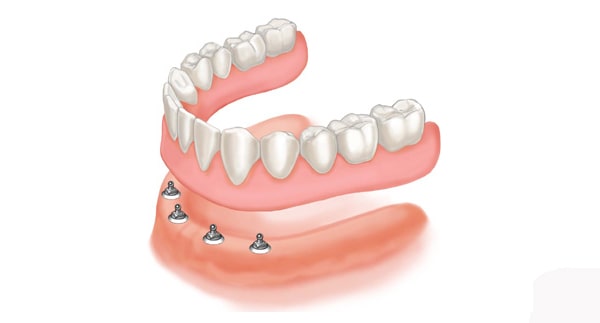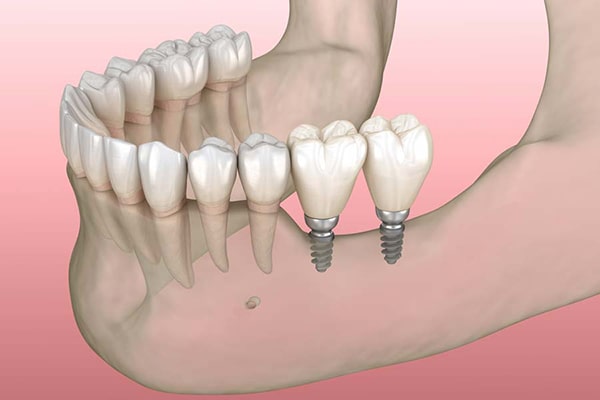All about Mini Dental Implant you need to know
Mini Dental Implant surgery is often advised by dentists for people with narrow dental arches and who are using removable jaws. So what exactly is Mini Implant? How is the process done? Is it good? How much is the price? Find out more in this article.
Contents
What is Mini Dental Implant surgery?
Mini Implant is similar to regular Implant, the only difference is in the size of the Implant post.
Mini Implant posts only have diameters ranging from 1.8 to 3.3 mm & lengths from 10 to 15mm. As for the traditional Implant, the diameter will be twice as large, from 3.4 to 5.8 mm.

In what cases can Mini Dental Implant be performed?
Whether to use Mini Implant post or not depends on the dental condition. The dentist will make the decision based on your specific case.
Usually, small implants are used in the following cases:
Narrow jawbone structure
For people with a narrow distance between the two roots (usually in the incisors, canines, and premolars area), regular Implant posts will be difficult to fit. Then the doctor will consider using a Mini Implant post instead.
Low jawbone density
Small Implant posts do not require too much jawbone to hold. Therefore, for people with jawbone loss, dentists can use this technique to avoid losing time for bone grafting.
Removable dentures
Removable dentures are often loose and easy to slip when chewing. Using a mini implant post to plug into the jawbone will help reinforce the removable jaw firmly.
What are the advantages and disadvantages of Mini Dental Implant procedure?
Mini Dental Implant is currently a solution that many customers are interested in because of its outstanding advantages compared to the traditional Titanium post. However, there are still many reasons why doctors rarely use this type of post.
Advantages
- Simple, less invasive surgery: Due to the small size of the Mini Implant post, it is easier to be placed into the jawbone than the regular post.
- No bone grafting required: Most Mini Implants do not require additional bone grafts.
- Less pain, faster healing: Due to minimal jawbone invasion, there is less pain after the surgery. Wounds also heal slightly faster.
- Prevent bone loss: Similar to traditional Implant posts, Mini Implants also provide the ability to prevent bone loss.
- High success rate: According to statistics, the rate of complications or failure in Mini Implant is very rare. So when using this method, the success rate is almost 100%.
- Better aesthetics: No one can recognize or know you are using the Mini Implant (except the dentist and yourself)
- High stability: The Mini Implant post will reinforce the stability and certainty of the removable jaw. Since, the denture will not slip every time you eat and chew.
- Reasonable cost: Each Mini Implant post is only 1/2 price compared to normal Titanium post.
Disadvantages
- Short lifetime: On average, Mini Implant posts can only be used for about 8-10 years. Depending on the usage of each person, the time will be shorter or longer.
- Unsuitable for molars: The load-bearing capacity of Mini Implant teeth is relatively poor. Therefore, if the restoration is in the molars, the bone will easily break or be damaged.
- Unsuitable for people who grind their teeth: The capacity of the Mini Implant cylinder is also not suitable for people with the habit of grinding. Pressure when grinding teeth will easily damage the mini post.
- May need 2 posts at a position: Due to the relatively poor load capacity, in some cases, 2 small Implant posts will be needed at a position. Thus, the cost may be higher than using traditional Titanium posts.
Overall, it can be seen that the Mini Dental Implant method is a good solution for many objects. However, if you want to use it for a long time, you should still choose a traditional Implant.
The process of Mini Dental Implant surgery
The steps to perform Mini Implant surgery are much faster and simpler than traditional Implant.
- Step 1: The dentist examines, takes Cone-Beam CT and decides whether the patient can use the Mini Dental Implant method.
- Step 2: The dentist gives the patient a local anesthetic and places the Mini Implant post.
- Step 3: The dentist sutures the wound and insert temporary dentures.
- Step 4: The patient goes home to rest and waits until the root post integrates firmly with the jawbone.

Because the diameter of the Mini Implant is relatively small, it will cause less damage to the jawbone when inserted. In many cases, if the root post is quite solid right after taking down the teeth, it is possible to restore porcelain teeth right away.
However, to ensure safety, the dentist will still leave some time for the mini post to fully integrate, which usually takes 2-3 months.
How to take care of your teeth after the Mini Dental Implant?
Proper oral care after Mini Implant is very important and affects the durability of the post. In order to have the longest use of the post, you need to comply with the following requirements:
- Keep your teeth clean and brush your teeth every 2 days.
- Do not chew hard objects or eat too much.
- Do not smoke for at least the first 2 months from the date of installation.
- Limit vigorous physical activity.
Although Mini Implant post is cheap and the Mini Dental Implant process is quick and simple, you still need to consult a dentist.
